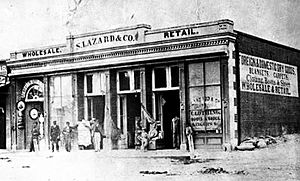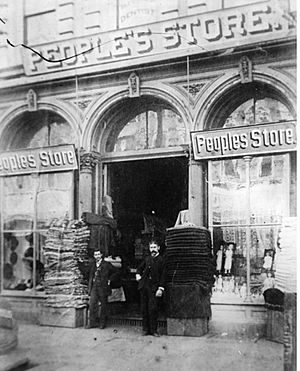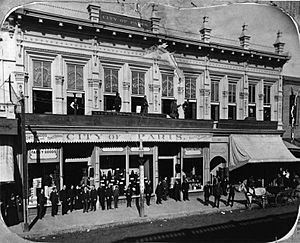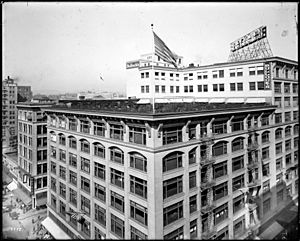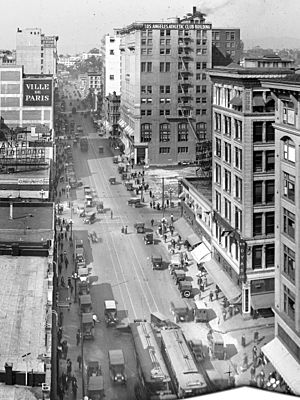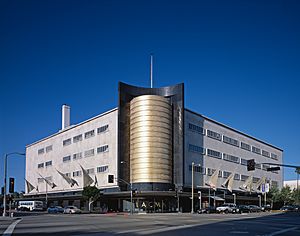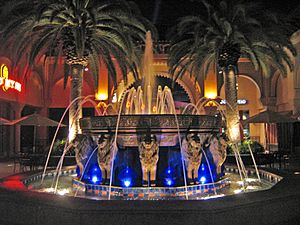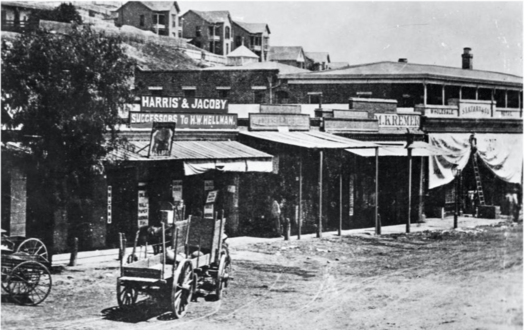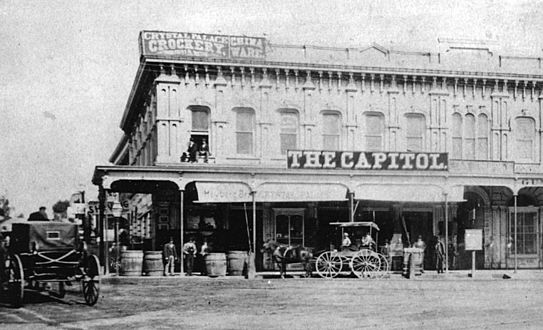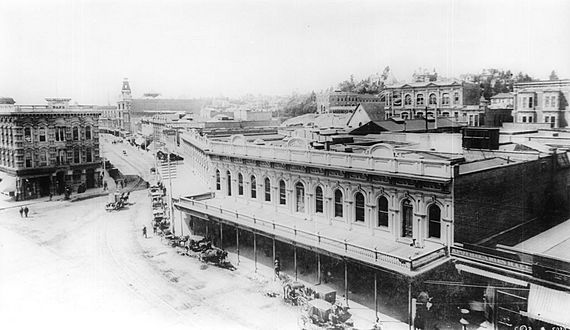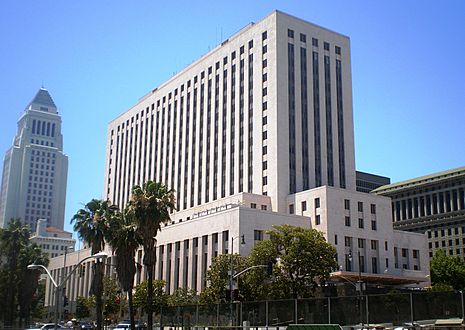History of retail in Southern California facts for kids


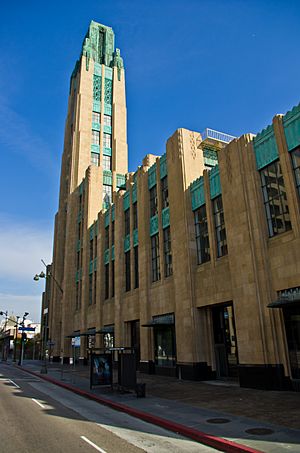
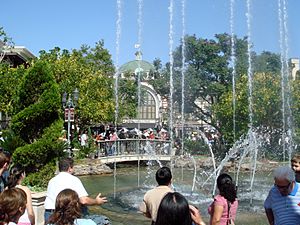
Retail in Southern California dates back to its first dry goods store that Jonathan Temple opened in 1827 on Calle Principal (Main Street), when Los Angeles was still a Mexican village. After the American conquest, as the pueblo grew into a small town surpassing 4,000 population in 1860, dry goods stores continued to open, including the forerunners of what would be local chains. Larger retailers moved progressively further south to the 1880s-1890s Central Business District, which was later razed to become the Civic Center. Starting in the mid-1890s, major stores moved ever southward, first onto Broadway around 3rd, then starting in 1905 to Broadway between 4th and 9th, then starting in 1915 westward onto West Seventh Street up to Figueroa. For half a century Broadway and Seventh streets together formed one of America's largest and busiest downtown shopping districts.
Branches in what were then the suburbs like Hollywood and Mid-Wilshire were built in the 1920s, and local department stores as well as branches of national variety stores and J. C. Penney opened in local downtowns in the outlying towns that would become the suburbs. However, real suburbanization took off in the 1950s with the building of shopping centers across the suburbs. By the 1960s few suburbanites ventured to Downtown Los Angeles to shop, and regional and community shopping centers flourished. Local chains Bullock's, The Broadway, J. W. Robinson's, May Co. and Buffums built out dozens of branches each in malls across Southern California, as did Sears and J. C. Penney.
In the 1990s the local department store chains either closed or were folded into Macy's. Alternative shopping center formats like power centers, lifestyle centers, and outlet malls arose, strip malls flourished, and as elsewhere in the country, shopping malls began to close or were transformed into strip-style community shopping centers. Retail in Southern California today is much like anywhere else in the United States, with a variety of shopping center formats, and ever-increasing competition from online shopping and major fallout of closed stores as a results of the 2020 COVID-19 pandemic which closed stores for months.
Contents
Origins near the Plaza (1827-1870s)
The first dry goods store was opened by Jonathan Temple in 1827 when Los Angeles was a Mexican pueblo. Some of the dry goods retailers who opened over the following decades included two Harris & Frank (1856) and Desmond's (department store) (1862), that would grow into local chains that survived until the end of the 20th century. The dry goods stores migrated in the 1860s and 1870s a few blocks south of the Plaza to Temple, First, and Main streets, and some would grow into the first department stores, such as the City of Paris, Jacoby Bros., Hamburger's, and Coulter's.
Downey blocks
-
North end of the Downey Block along the west side of Main St., 1887. Temple Block at left; Spring Street runs towards the Phillips Block (tower) in the background at center-left. -
Today, the corner is home to the 1940 Spring Street U.S. Courthouse
On the northwest corner of Temple and Main streets stood four buildings in succession, the first two of which had a key role in the history of retail in Southern California, as it was home to a number of upscale retailers who would later grow to be big names in the city, and some, regional chains. The site later became a Post Office and Federal Building, and is now the Spring Street U.S. Courthouse.
- Old Downey Block (?-1871), northwest corner of Temple and Main, Replaced by the Downey Block (1871-1910). Retailers that got their start here included Harris & Jacoby, forerunners to the Harris & Frank clothing chain and the large Jacoby Bros. department store; and M. Kremer, forerunner of the Los Angeles City of Paris.
- Downey Block (1871–1910), replaced by the New Post Office in 1910. Retailers who were located here included Coulter's (1878-9), Jacoby Bros. (1878-9), and Quincy Hall (1876–1882), forerunner of Harris & Frank.
Temple Block
Temple Block was actually a collection of different structures that occupied the block bounded by Spring, Main and Temple, erected in 1858 and expanded in 1871. The block had many law offices and also a key role in the retail history of Los Angeles, as it was the first home to several upscale retailers who would become big names in the city: Desmond's (1870–1882) and Jacoby Bros. (1879–1891).
By the 1880s, most upscale retailers would have migrated southwestward, clustering around First and Spring in what had become the new center of the 1880s-1890s central business district, which was demolished in the 1920s–1950s and it today the site of the (mostly) government buildings of the Civic Center.
Broadway as regional shopping mecca
The major department stores started to migrate to, or were built along, Broadway between 3rd and 9th streets around 1905–1915, and built very large stores that would over the following decades expand to cover entire or nearly entire city blocks. The Broadway led the way in 1896, Hamburger's (later May Company California in 1906, and Bullock's in 1907. Starting with J. W. Robinson's in 1915, the more upscale stores also migrated westward along Seventh Street as far as Figueroa, where Barker Bros. built a million-square-foot store in 1926. Both streets together formed a very large downtown shopping district.
The square footage of the four largest Downtown L.A. department stores alone — Bullock's at 806,000 sq ft (74,900 m2), The Broadway at 577,000 sq ft (53,600 m2), May Co. at over 1,000,000 sq ft (93,000 m2) and J. W. Robinson's (7th St. at Hope) at 623,700 sq ft (57,940 m2) — totaled over three million square feet, the size of American Dream Meadowlands, America's largest mall today.
Table of department stores on Broadway and 7th streets
| Store | Opened | Left | Moved or closed? | Location | Sq ft | Sq m | Architects | Current use | |
|---|---|---|---|---|---|---|---|---|---|
| SPRING ST. BETWEEN TEMPLE AND SECOND | |||||||||
| Coulter's (1st sequential location) |
1884 | 1898 | Moved | Hollenbeck Block, SW corner 2nd & Spring | Historic Broadway station | ||||
| Hamburger's (1st seq. loc.) | 1888 | 1908 | Moved | Phillips Block, Franklin & Spring | Burgess J. Reeve | Site of City Hall | |||
| Mullen & Bluett | 1889 | 1910 | Moved | 101–5 N. Spring | Empty lot | ||||
| Jacoby Bros. (1st seq. loc.) |
1891 | 1900 | Moved | 128–134(–138) N. Spring at Court | Site of City Hall | ||||
| The Hub | 1896 | 1916 | Moved | Bullard Block, Spring at Court | Morgan & Walls | Site of City Hall. The Hub moved to 430 S. Broadway. | |||
| BROADWAY | |||||||||
| Broadway from 2nd to 3rd | |||||||||
| Ville de Paris (A. Fusenot Co.) |
1893 | 1898 | Moved | Potomac Block, 221-3 S. Broadway | Block, Curlett & Eisen | added to Coulter's late 1907, demolished 1958, now a parking lot | |||
| Coulter's (3rd seq. loc.) |
1905 | 1917 | Moved | Potomac Block: 225-7-9 S. B'way through to 224-6-8 S. Hill. 1907: expanded into 219-221-223 B'way. | 157,000 | 14,586 | Block, Curlett & Eisen | demolished, site of parking lot | |
| Boston Dry Goods (J.W. Robinson Co.) |
1895 | 1915 | Moved | 237–241 S. Broadway | Theodore Eisen, Sumner Hunt | Parking lot | |||
| I. Magnin/ Myer Siegel (1st seq. loc.) |
1899 | ? | Moved | Irvine Byrne Block, 251 S. Broadway |
Sumner Hunt | Wedding chapel | |||
| Broadway from 3rd to 4th | |||||||||
| Coulter's (2nd seq. loc.) |
1898 | 1905 | Moved | 317–325 S. Broadway through to 314–322 Hill St. (Homer Laughlin Bldg.) | 86,000 | John B. Parkinson | became Ville de Paris Now Grand Central Market |
||
| Jacoby Bros. (2nd seq. loc.) | 1899 | 1935-6 | Moved | 331-333-335 S. Broadway | 60,000 | 5574 | John B. Parkinson | Was "Boston Store" in late 1930s. Currently independent retail. 2 of 4 floors were removed. | |
| Ville de Paris (2nd seq. loc.) |
1905 | 1917 | Moved. | 317–325 S. Broadway through to 314–322 Hill Street Homer Laughlin Building |
96,000 | 8919 | John B. Parkinson | Grand Central Market | |
| J. J. Haggarty New York Store |
1905 | 1917 | Moved | 337–9 S. Broadway | Small retail. Only 2 stories remain. | ||||
| J. M. Hale (Hale’s) | 1909 | ? | ? | 341-343-345 S. Broadway | retail, top floors were removed | ||||
| BROADWAY south of 4th St. | |||||||||
| Broadway from 4th to 5th | |||||||||
| The Broadway (1st seq. loc.) |
1896 | 1973 | Moved | SW corner 4th & Broadway, later through to Hill | 1924, 577,000 | 53,605 | Junipero Serra State Office Building | ||
| Bon Marché | 1907 | Liquidated | Bumiller Building, 430 S. Broadway | ||||||
| The Hub (2nd seq. loc.) |
1907 | 1916 | Moved | 430 S. Broadway | In 1907, The Hub opened at the former Bon Marché. In March 1916, The Hub moved to 337–9 S. Spring. closing in 1922. | ||||
| Myer Siegel (2nd seq. loc.) |
1899 | ? | Moved | 455 S. Broadway | Became part of Fallas Paredes | ||||
| Broadway from 5th to 6th | |||||||||
| Fifth Street Store (Steele, Faris & Walker), later Walker's |
1905 | ? | Closed | SW corner 5th & Broadway | 1917: 278,640 | 1917:25,887 | Replaced existing store with new building in 1917. Building later housed Ohrbach's |
||
| Ohrbach's | Closed | SW corner 5th & Broadway | Former Walker's store. Building later housed Ohrbach's |
||||||
| Silverwoods | 1904 | ? | ? | 556 S. Broadway (NE corner of 6th) | 1920: 115,420 | 1920: 10,723 | Broadway Jewelry Mart | ||
| Broadway from 6th to 7th | |||||||||
| Jacoby Bros. (3rd seq. loc.) |
1936 | 1938 | Liquidated | 605 S. Broadway | Became a Zukor's (1940), now mixed-use | ||||
| Central Dept. Store | 1907 | 1908 | 609–619 S. Broadway | 85,000 | 7897 | Samuel Tilden Norton | Demolished, now site of Los Angeles Theatre | ||
| Myer Siegel (3rd seq. loc.) |
Moved | 617 S. Broadway | Samuel Tilden Norton | Demolished, now site of Los Angeles Theatre | |||||
| Mullen & Bluett (2nd seq. loc.) | 1910 | 1960s | Moved | 610 S. Broadway (Walter P. Story Bldg.) |
Morgan, Walls & Clements | Mixed-use | |||
| Desmond's | 1924 | 1972 | Closed | 616 S. Broadway | 85,000 | 7897 | A. C. Martin | Renovated 2019 as office space, a restaurant and a rooftop bar. | |
| Harris & Frank 2nd concurrent location |
1947 | 1980 | Closed | 644 S. Broadway (Joseph E. Carr Building) |
Robert Brown Young | ||||
| Bullock's (1st seq. loc.) |
1907 | 1983 | Closedb | NW corner 7th & Broadway by 1934, most of the block 6th/ 7th/ Broadway/ Hill |
1907: 350,000 1934: 806,000 |
1907: 32,516 1934: 74,880 |
Parkinson & Bergstrom | St. Vincents Jewelry Mart | |
| Broadway from 7th to 8th | |||||||||
| F.W. Woolworth | 1920 | 719 S. Broadway | Ross Dress for Less | ||||||
| Reich and Lièvre | 1917 | c.1927 | 737-745 S. Broadway (Isaac Bros. Bldg.) | ||||||
| Broadway from 8th to 9th | |||||||||
| Hamburger's (2nd seq. loc.) After 1925: May Company (1st loc.) |
1906 | 1986 | Moved | SW corner 8th & Broadway by 1930, entire block 8th/ 9th/ Broadway/ Hill |
1906: 482,475 1930, >1,000,000 |
1906: 44,823, 1930 92,903 | Under renovation to become tech campus | ||
| Broadway from 9th to 10th | |||||||||
| Blackstone's | 1917 | 901 S. Broadway (SE corner 9th) | 118,800 | 11,037 | John Parkinson | Building became The Famous, now residential, retail |
|||
| Eastern Columbia | 1930 | 1957 | 849 S. Broadway through to Hill | 1930: 275,650 (expanded in 1950) | 1930: 25,609 | Claud Beelman | Residential condo | ||
| SEVENTH STREET (from Broadway west to Francisco) | |||||||||
| Seventh between Broadway and Hill | |||||||||
| Bullock's (see above) | |||||||||
| Seventh between Hill and Olive | |||||||||
| Ville de Paris, from 1919 B. H. Dyas | 1917 | 1933 | Liquidated | 420 W. 7th (SE corner Olive) | Dodd and Richards | L.A. Jewelry Mart | |||
| Seventh between Olive and Grand | |||||||||
| Haggarty's | 1917 | 1963 | Closed | Brockman Building, 520–530 W. 7th at Grand |
George D. Barnett, Barnett, Haynes & Barnett |
Apartments | |||
| Coulter's (4th seq. loc.) | 1917 | 1938 | Moved | 500 W. 7th (SW corner Olive) | Dodd and Richards | Mixed-use. Coulter's moved to Miracle Mile. | |||
| Seventh between Grand and Hope | |||||||||
| J. W. Robinson's (2nd seq. loc.) | 1915 | 1993 | Closed | 600 W. 7th ("7th, Hope & Grand") | 1915: 400,000 1923: 623,700 sq ft (57,940 m2) |
1915: 37,161 1923: 57,944 |
Noonan & Richards (1915), Edgar Mayberry/Allison & Allison (1934 remodel) | Mixed-use | |
| Desmond's 7th St. (2nd seq. loc.) | 1934, expanded 1937 | Closed | 2nd Union Oil Building, 617 W. 7th. St. | 22,500 (1937) | 2090 | Alexander Curlett and Claude Beelman | Walgreens | ||
| Seventh between Hope and Flower | |||||||||
| The Broadway (2nd loc.), later Macy's | 1973 | Open | Open | Broadway Plaza 750 W. 7th (Hope to Flower) | 250,000 | 23,226 | Charles Luckman | In operation | |
| Desmond's 7th St. (1st seq. loc.) (B'way store remained open) |
1927 | 1934 | Moved | Roosevelt Building, 717 W. 7th St. | Alexander Curlett and Claude Beelman | Shoo Shoo Baby (restaurant) | |||
| Barker Bros. (final downtown loc.) | 1926 | 1984 | Closed | 818 W. 7th (Flower to Figueroa) | 1,000,000 | 93,000 | Curlett and Beelman | Offices | |
| Seventh between Figueroa and Francisco/I-110 | |||||||||
| Bullock's (2nd seq. loc.), later Macy's | 1986 | 1996 | Closed | Seventh Market Place now FIGat7th, 735 S. Figueroa | Jon Jerde | Gold's Gym (level M1), Target (M2), Zara (M3) | |||
| May Company (2nd seq. loc.), later Macy's | 1986 | 2009a | Closed | Nordstrom Rack (level M1), Target (M2), H&M (M3) | |||||
| FLOWER STREET from Seventh to Eighth | |||||||||
| Weatherby-Kayser shoes | 1925 | 715–9 S. Flower | |||||||
| Myer Siegel (4th seq. loc.) | 1927 | 733 S. Flower | |||||||
| Parmelee-Dohrmann (homewares) | 1927 | 741–7 S. Flower | |||||||
aas Macy's, breopened in 1986 at Citicorp Plaza, now FIGat7th.
The first outlying and suburban shopping districts
In the first half of the 20th century, some outlying towns also saw their downtowns grow into large regional shopping districts, and some of the local department stores based there would become small regional chains after World War II, like Buffums and Roberts (Long Beach), Boston Stores (Inglewood), Harris Co. (San Bernardino), Walker Scott and Marston's (San Diego), and Nash's (Pasadena).
Hollywood
Hollywood established itself as the only major suburban shopping district of the pre-World War II era, attracting branches of local and national stores, both mainstream and upscale, between the late 1910s and the late 1920s. In the 1920s Hollywood Boulevard and adjacent streets became a major regional shopping district, both for everyday needs and appliances, but increasingly also for high-end clothing and accessories, in part because of the nearby film studios. Chains that opened includes Schwab's in 1921, Mullen & Bluett in 1922, I. Magnin in 1923, Myer Siegel in 1925, F. W. Grand and Newberry's (dime stores) in 1926–8, and Roos Brothers in 1929. The independent Robertson's department store, at 46,000 square feet (4,300 m2) and 4 stories tall, opened in 1923. In 1922, stock was sold to finance construction of a much larger department store at Hollywood and Vine, originally to have been a Boadway Bros. When Boadway's went out of business the next year, B. H. Dyas, a Downtown Los Angeles-based department store, opened in the 130,000-square-foot (12,000 m2) building in March 1928, then sold their lease to The Broadway in 1931 – the building still a landmark today, known as the Broadway Hollywood Building. By 1930 the shopping district consisted of over 300 stores. The area would later face competition from areas along Wilshire Boulevard: the easternmost around Bullocks Wilshire which opened in 1929, second the Miracle Mile, and finally, the shopping district of Beverly Hills, where Saks Fifth Avenue opened a store in 1938.
Branches of downtown department stores
Bullock's and B. H. Dyas department stores built the first suburban branches in 1929, in Mid-Wilshire and Hollywood respectively, Bullock's and Desmond's opened boutique stores in Westwood Village and Palm Springs, Sears built several stores in the suburbs (1927-1939), and Saks Fifth Avenue opened in Beverly Hills, which would then soon replace Hollywood as the city's largest upscale suburban shopping district. But Downtown Los Angeles was still a goliath of retail square footage compared to anything else in Southern California.
1950s-1980s: Suburban shopping centers and malls
True suburbanization took off after World War II with the opening of very large shopping centers like Crenshaw Center (1947), Lakewood Center (1952), Valley Plaza (1951) – in the mid-1950s claiming to be the largest shopping center on the West Coast of the United States and the third-largest in the country, and Panorama City Shopping Center (1955). Bullock's built a series of four "Fashion Squares", starting with Santa Ana Fashion Square in 1958, and Broadway and Robinson's also backed new suburban centers. By the 1960s, most Los Angeles area shoppers didn't bother (or had no particular need) to go to Downtown Los Angeles to shop, far from most suburbs and with more difficult parking facilities than in the suburbs. Broadway instead continued as a great shopping hub, but from the 1970s through the mid-2000s, for immigrant Latin Americans and local Hispanic shoppers with its bazaar (or indoor swap meet-type) offerings and quinceañera and wedding dress shops. More and more regional malls were built, as well as some community shopping centers with single department stores, for example Honer Plaza in Santa Ana, Orangefair Mall in Fullerton, and three centers in three centers in Santa Fe Springs alone. The downtown areas of the older suburbs like Long Beach, Santa Ana, Anaheim, and Whittier, lost their function as regional shopping districts, except for those building downtown enclosed malls like Plaza Pasadena, Santa Monica Place and San Bernardino's Central City Mall, and Beverly Hills, which retained its status as the premiere luxury shopping district. Pedestrian malls in outlying downtowns were largely unsuccessful such as the Golden Mall in Burbank, Pomona Mall, and Riverside Main Street Mall and, until its renovation, Santa Monica's Third Street Mall.
Discount department stores and membership stores, mostly Los Angeles-based, like The Akron, Fedco, Fedmart, Gemco, Mervyn's, Pic 'N' Save, Unimart, White Front, and Zody's, thrived in this era as well.
The end of the Los Angeles chains
Timeline of transformation to Macy's
| Chain | 1988 | 1990 | 1993 | 1994 | 1995 | 1996 | 2005 |
|---|---|---|---|---|---|---|---|
| Bullock's Wilshire (BW) and I. Magnin |
Acquired by Macy's | BW merged into I. Magnin | Federated buys Macy's |
I. Magnin chain closed, incl. former BW stores | |||
| Bullock's | Acquired by Macy's | Stores become Macy'sa | |||||
| The Broadway | Acquired by Federated | Stores become Macy'sa | |||||
| Robinson's and May Co. Cal. |
Robinson's and May Co. Cal. merged as Robinsons-May | Acquired by Federated, stores become Macy'sa | |||||
| aor close or are sold or are transformed into Bloomingdales | |||||||
In the 1990s, via a series of takeovers, the "big four" Los Angeles-based department stores: Bullock's, The Broadway, Robinson's and May Company, plus Bullocks Wilshire and I. Magnin, became part of Macy's, which in turn became part of Federated Department Stores (since renamed Macy's Inc.), and were turned into Macy's, Bloomingdales, or were sold or closed.
In 1988, Robert Campeau took over Federated and sold Bullock's and I. Magnin to Macy's. In 1990 Bullock's Wilshire (BW) became part of I. Magnin and some BW branches were closed. However, Macy's went bankrupt in 1992, and Federated bought Macy's in 1994, and in 1995, Federated's Macy's closed the entire I. Magnin chain.
In 1995 Federated bought Broadway Stores, Inc. and thus, The Broadway chain. Macy's changed the nameplate of Broadway and Bullock's stores to Macy's, except some locations which it converted to Bloomingdales.
Owner May Department Stores combined its midrange May Company and upscale Robinson's chains into a single 45-store midrange chain, Robinsons-May, in 1993. In 2005, Federated took over May and Robinsons-May was dissolved, and as with Bullock's and Broadway nine years prior in 1996, some stores became branches of Macy's, while others were closed, sold, or transformed into Bloomingdales.
National discount big box retailers like Walmart and Target became more popular during this people and some malls, like Panorama City Shopping Center, became anchored only by discount stores. The local discount store chains closed.
Today
New models of shopping centers thrived. Large power centers with multiple big box retailers, and older malls were demolished to make way for community centers. The strip mall thrived. A renewed Downtown Burbank as well as Third Street Promenade in Santa Monica were successes, as are the outdoor, pedestrian-oriented spaces of The Grove at Farmer's Market and Westfield Century City. Lifestyle centers like Irvine Spectrum Center and outlet malls like The Citadel were built. Many of the largest traditional enclosed shopping malls still thrive, such as South Coast Plaza, Los Cerritos Center, and Westfield Santa Anita, to name a few. The formerly busy retail districts of suburban downtowns such as Santa Ana, City of Orange, Burbank, North Hollywood, Riverside, and Pasadena are now often entertainment and arts districts with outdoor dining and eclectic, artsy retail mix.
Today, no department store chains are based in Southern California except National Stores/Fallas Paredes, and Curacao, both discount retailers targeting the Hispanic market.


